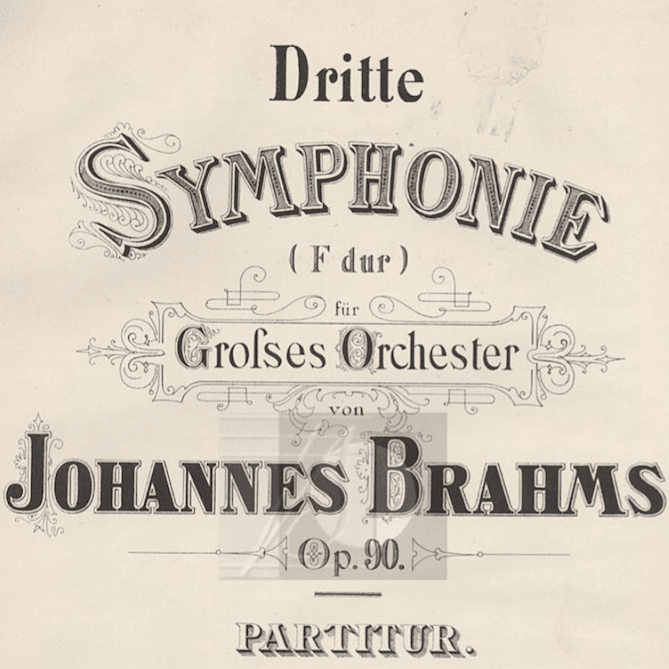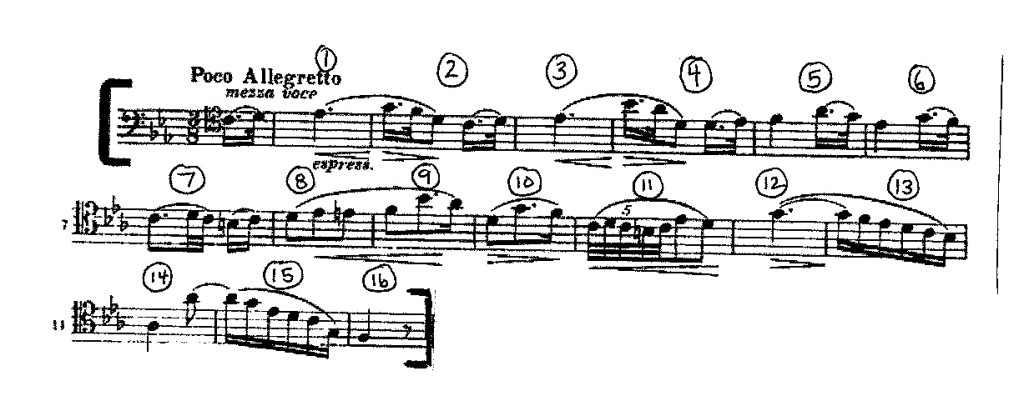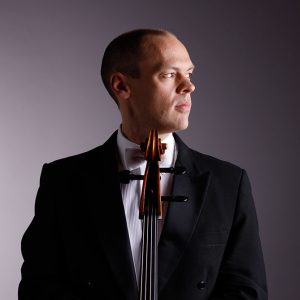
Beneath the Surface of Brahms
Brant Taylor
Brahms’ 3rd Symphony Cello Excerpt
A successful audition performance involves showing many different sides of yourself, musically, in a condensed period of time. Therefore, it is useful if not imperative to conceive each excerpt on a list in its own distinct world of character and color. Despite being works from the same composer, the well-known cello audition excerpt from Brahms’ Second Symphony, which we previously discussed, and the cello audition excerpt from Brahms’ Third Symphony, which is the subject of this post, present quite different opportunities. While these suggestions are not the only solutions to the challenges presented by this excerpt, they are a starting point for practice and discussion and illustrate some of the details that must be carefully considered in any successful performance.
Sound Production
In thinking about sound and character, let’s remember that this excerpt isn’t taken from the symphony’s slow movement, but rather from the Poco allegretto, a wistful intermezzo. Sound is to some degree individual, of course, but more “air” and less density, particularly compared to the desired sound of the Second Symphony excerpt, usually help to capture this movement’s character. Avoid restricting or overly concentrating the bow speed, but remember that a seamless legato is of paramount importance regardless of how freely you use the bow.
Pick-up
Because control of tempo, rhythm, sound quality, and phrasing are all on display from the very first moment, this excerpt can seem challenging to begin. Start in the best part of the bow for the right sound color and bow distribution regardless of what bowing you choose. In terms of emphasis, the pick-up should sound like a pick-up, the downbeat like a downbeat. Be in motion before the sound starts by giving yourself an appropriate preparatory gesture to begin. The dotted rhythms should be accurate (not triplets or double-dotted), but lyrical and melodic. They shouldn’t call attention to themselves only for being “correct.”
Bar 1
Use the longer notes in this excerpt to really develop your sound, so the printed hairpins aren’t just increases in decibel level but evolving color as well. Speeding up the bow toward bar 2 and changing speed and/or width of vibrato can help considerably in keeping the long notes interesting and natural parts of your phrase.
Bar 2
The swells and hairpins in this excerpt are not all created equal. How high does this one go? It depends on how you imagine the one two bars later, which goes to a higher pitch via a wider interval. Avoid clipping the D-natural on beat 2 short in order to “prepare” for the pickup to bar 3 (and remember to apply the same idea two bars later.) Within your chosen tempo, find time to finish notes elegantly before moving on.
Bars 3-4
Similar to bar 1, but since the hairpin goes to a different place, consider developing the E-flat with a different nuance this time. If the shift to the B-flat feels awkward, the culprits are most often a lack of preparation for the shift (resulting in a motion that is too quick and angular), ill-timed preparation (either too soon or too late to be useful), or confusion about which type of shift you want to execute. There are many possible fingering choices, but each one lends itself to certain types of shifts and timings. Resist choosing fingerings too quickly in general. These decisions should naturally depend on your specific expressive aims, not the other way around. In this case, if you are seeking an audible portamento to the B-flat for expressive purposes, it should be deliberate and conscious, and may affect your chosen fingering. A tasteful glide up to the B-flat can sound very natural and vocal. However, audible glides downward from the A-flat to the D-natural are harder to pull off without the slide sounding utilitarian, like transportation—many players cross to the D string for the D-natural for this reason. In any case, transcend the cello and seek to produce natural and singing sounds that are unencumbered by the technical demands specific to the cello.
Bars 5-6
The printed bowing can result in unwanted emphases on beat 3. One way to avoid the tendency is by hooking each third beat into the previous bow direction. Because the line is coming down in register, consider inflecting your sound to emphasize the direction by playing slightly less on the downbeat of bar 6, and perhaps even less on the downbeat of bar 7.
Bar 7
Like the dotted rhythms in the preceding measures, play the two 32nd notes in this bar accurately but lyrically.
Bars 8-9
Bar 8 contains the starting point of the longest crescendo in the excerpt. Let the sound develop with each note, paying close attention to where the high point of this crescendo is. I use the fingering 1-3 from F to B-flat to avoid calling too much attention to the B-flat with a juicy slide. It is the highest pitch, but not the high point of the phrase. Keep your sound developing through the B-flat and A-flat to the next bar. It’s interesting to note that there are two similar places in the Second Symphony excerpt, where the highest pitch comes just before the actual phrase goal: bars 5 and 9.
Bar 10
This downbeat is perhaps the loudest you will play in the excerpt. Begin to evolve your sound immediately afterward so the journey away from the peak is as natural as on the way up.
Bars 11-16
The quintuplet rhythm is interesting enough on its own, so resist the temptation to add rubato or agogic accents—they can make it seem as though you are playing an incorrect rhythm. Bar 11 is the starting point of another hairpin, but not only does it not last as long as the previous one, it also falls closer to the end of the phrase. For these reasons, don’t let the G-natural “compete” with the high point two bars earlier. Play a more modest swell, and use entire length of the G-natural to change your sound into what you want it to be for the final few bars of the excerpt. Beginning in bar 13, use a sound that shows your knowledge of the changing role of the cello part as the main melody goes elsewhere in the orchestra.
Subjects: Auditions, Orchestra, Repertoire

